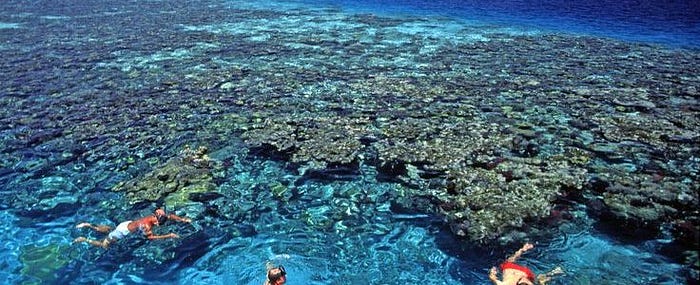What is the importance of coral reefs?
Coral Reefs
Coral reefs are made up of colonies of hundreds to thousands of tiny individual corals, called polyps. These marine invertebrate animals have hard exoskeletons made of calcium carbonate and are sessile, meaning permanently fixed in one place.
Coral reefs are not only beautiful, but they are also incredibly diverse ecosystems.
“Orange and speckled and fluted nudibranchs slide gracefully over the rocks, their skirts waving like the dresses of Spanish dancers.” (John Steinbeck, from Cannery Row, 1945.)
1-Great Barrier Reef
This is the world’s largest coral system, located in the coral sea, off the coast of Queen's land Australia. It stretches over 2300km. It can be seen from outer space. It is also called Marine Park.
Citizens of the Great Barrier Reef CEO Andy Ridley told.
“We even found a shipwreck up in the north from the 1840s. That kind of gives you an idea of not only how big the place is, but even now you can find a shipwreck that’s been there for nearly 200 years.

Francois Gohier — VWPics/Universal Images Group/Getting Images
2-Cancun Reef
This is the world's 2nd largest barrier reef off the coast of Mexico. It is also called Mesoamerican System. Cancun boasts beautiful beaches, warm crystal clear waters, and has hundreds of resorts along the shores of the Mexican Caribbean. But did you also know that Cancun is home to the second-largest barrier reef in the world? The Mesoamerican barrier reef spans from Mexico all the way down to Honduras and is home to thousands of fish, mammals, corals, and more. The barrier reef is in danger of bleaching and eventually dying due to human interference.

Importance
1. Coral reefs contain staggering biodiversity.
2. Coral reefs provide food to millions of humans.
3. Coral reefs protect and create land.
4. Coral reefs might supply natural medicines. Coral reefs are a likely place to find natural products, due to their tremendous biodiversity.
5. Coral reefs are beautiful and intrinsically full of wonder. Nothing much compares to diving below the surface of clear turquoise water and seeing a natural wonderland more intricate and complex than you could possibly dream up.
6. These protect coastlines from the damaging effects of wave action and tropical storms
7. These provide habitats and shelter for many marine organisms
8. These are the source of nitrogen and other essential nutrients for marine food chains
9. These assist in carbon and nitrogen-fixing
10. These help with nutrient recycling.
11. Healthy coral reefs support commercial and subsistence fisheries as well as jobs and businesses through tourism and recreation.
Despite their great economic and recreational value, coral reefs are severely threatened by pollution, disease, and habitat destruction. Once coral reefs are damaged, they are less able to support the many creatures that inhabit them and the communities near them. When a coral reef supports fewer fish, plants, and animals, it also loses value as a tourist destination.
“This much is certain: We have the power to damage the sea, but no sure way to heal the harm.” (Sylvia Earle, “Sea Change: A Message of the Oceans.” New York: Fawcett Columbine, 1996.)
References
1. Spalding, M., Spalding, M. D., Raviolis, C., & Green, E. P. (2001). World atlas of coral reefs. Univ of California Press.
2. Knowlton, N. (2001). The future of coral reefs. Proceedings of the National Academy of Sciences, 98(10), 5419–5425.
3. Hughes, T. P., Baird, A. H., Bellwood, D. R., Card, M., Connolly, S. R., Folk, C., … & Roughgarden, J. (2003). Climate change, human impacts, and the resilience of coral reefs. science, 301(5635), 929–933.



2 Comments
Interesting
ReplyDeleteGreat 👍❤️
ReplyDelete